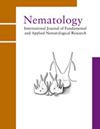来自西班牙和南非的salinaria Abolafia & Peña-Santiago (Rhabditida, Cephalobidae)的特征,包括该物种的首次分子研究
IF 1.2
4区 生物学
Q2 ZOOLOGY
引用次数: 1
摘要
盐藻Stegelletina salinaria是从西班牙和南非重新命名的。西班牙材料是从当地和附近地区的沙质土壤中收集的,而在南非的堆肥中收集的一个种群则进行了检查。该种的特征是体积小(0.27-0.41mm),侧野有三个切口,唇区有三对齿状唇,每对唇有四个尖齿,初级腋窝有一个大的保护突,次级腋窝缺乏保护突,神经环和峡部水平的分泌排泄孔,受精囊和外阴后子宫囊发育不良,雌性尾圆锥形,末端圆形透明,雄性未知。提供了描述、光学显微照片和扫描电子显微镜图像、插图和分子分析。18S和28S rDNA序列分析表明,来自西班牙和南非的盐藻分离株彼此之间以及与Stegelletina的其他物种有密切的亲缘关系,同时也表明与Nothacrobeles、Scottnema和Stegelleta(28S树)和Zeldia(18S树)的一些物种有密切关系。本文章由计算机程序翻译,如有差异,请以英文原文为准。
Characterisation of Stegelletina salinaria Abolafia & Peña-Santiago, 2003 (Rhabditida, Cephalobidae) from Spain and South Africa including the first molecular study of the species
Stegelletina salinaria is redescribed from Spain and South Africa. Spanish material was collected in sandy soil from the type locality and a nearby area, while one population collected in compost was examined from South Africa. The species is characterised by its small size (0.27-0.41 mm), lateral field with three incisures, lip region with three pairs of dentate lips bearing four tines each, primary axils bearing a large guarding process, secondary axils lacking guarding processes, nerve ring and secretory-excretory pore at isthmus level, spermatheca and post-vulval uterine sac poorly developed, female tail conoid with rounded hyaline terminus and males unknown. The description, light micrographs and scanning electron microscope images, illustrations and molecular analyses are provided. 18S and 28S rDNA sequence analyses show that the isolates of S. salinaria from Spain and South Africa are closely related to each other and to other species of Stegelletina, while also indicating a close relationship with some species of Nothacrobeles, Scottnema and Stegelleta (28S tree) and Zeldia (18S tree).
求助全文
通过发布文献求助,成功后即可免费获取论文全文。
去求助
来源期刊

Nematology
生物-动物学
CiteScore
2.60
自引率
33.30%
发文量
67
审稿时长
3 months
期刊介绍:
Nematology is an international journal for the publication of all aspects of nematological research (with the exception of vertebrate parasitology), from molecular biology to field studies. Papers on nematode parasites of arthropods, and on soil free-living nematodes, and on interactions of these and other organisms, are particularly welcome. Research on fresh water and marine nematodes is also considered when the observations are of more general interest.
Nematology publishes full research papers, short communications, Forum articles (which permit an author to express a view on current or fundamental subjects), perspectives on nematology, and reviews of books and other media.
 求助内容:
求助内容: 应助结果提醒方式:
应助结果提醒方式:


